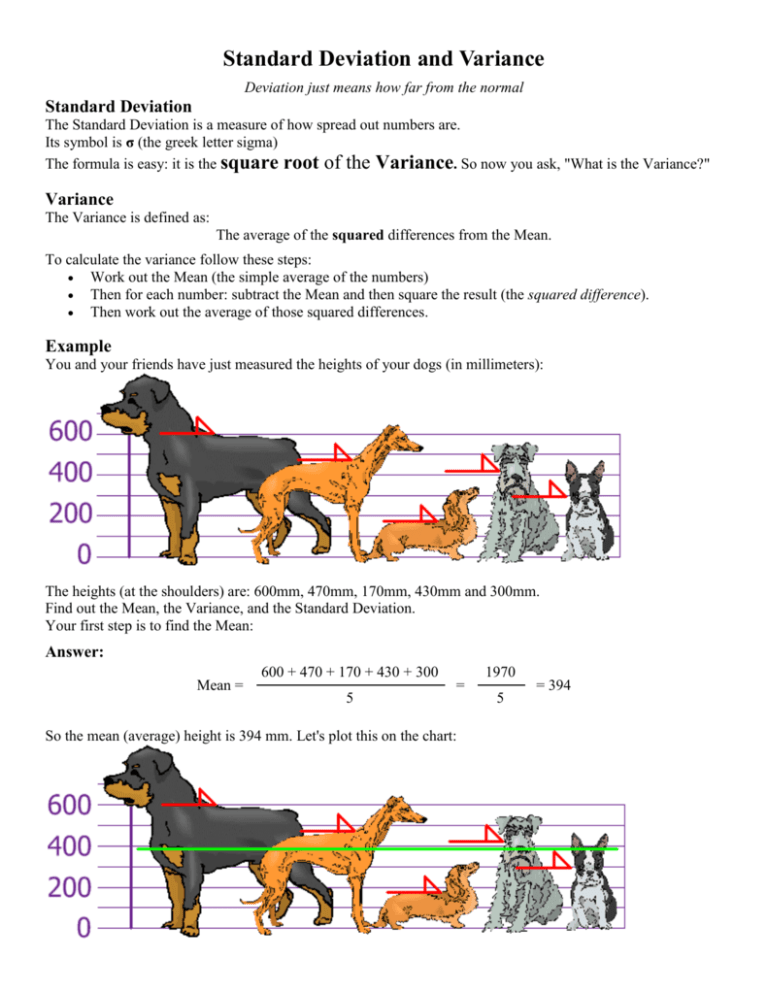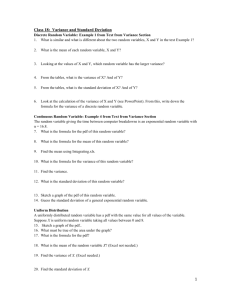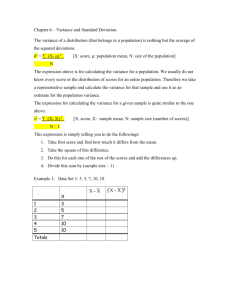Standard Deviation and Variance Explanation
advertisement

Standard Deviation and Variance Deviation just means how far from the normal Standard Deviation The Standard Deviation is a measure of how spread out numbers are. Its symbol is σ (the greek letter sigma) The formula is easy: it is the square root of the Variance. So now you ask, "What is the Variance?" Variance The Variance is defined as: The average of the squared differences from the Mean. To calculate the variance follow these steps: Work out the Mean (the simple average of the numbers) Then for each number: subtract the Mean and then square the result (the squared difference). Then work out the average of those squared differences. Example You and your friends have just measured the heights of your dogs (in millimeters): The heights (at the shoulders) are: 600mm, 470mm, 170mm, 430mm and 300mm. Find out the Mean, the Variance, and the Standard Deviation. Your first step is to find the Mean: Answer: Mean = 600 + 470 + 170 + 430 + 300 5 = So the mean (average) height is 394 mm. Let's plot this on the chart: 1970 5 = 394 Now, we calculate each dogs difference from the Mean: To calculate the Variance, take each difference, square it, and then average the result: 2062 + 762 + (-224)2 + 362 + (-94)2 108,520 2 Variance: σ = = = 21,704 5 5 So, the Variance is 21,704. And the Standard Deviation is just the square root of Variance, so: Standard Deviation: σ = √21,704 = 147.32... = 147 (to the nearest mm) And the good thing about the Standard Deviation is that it is useful. Now we can show which heights are within one Standard Deviation (147mm) of the Mean: So, using the Standard Deviation we have a "standard" way of knowing what is normal, and what is extra large or extra small. Rottweillers are tall dogs. And Dachsunds are a bit short ... but don't tell them! *Note: Why square ? Squaring each difference makes them all positive numbers (to avoid negatives reducing the Variance) And it also makes the bigger differences stand out. For example 1002=10,000 is a lot bigger than 502=2,500. But squaring them makes the final answer really big, and so un-squaring the Variance (by taking the square root) makes the Standard Deviation a much more useful number. Practice Problems 1. What is the standard deviation for the numbers: 75, 83, 96, 100, 121 and 125? a. 16.9 b. 17.1 c. 17.6 d. 18.2 e. 18.5 Practice Problems 1. What is the standard deviation for the numbers: 75, 83, 96, 100, 121 and 125? a. 16.9 b. 17.1 c. 17.6 d. 18.2 e. 18.5 Firstly find the mean: Mean = (75 + 83 + 96 + 100 + 121 + 125) ÷ 6 = 600 ÷ 6 = 100 2. Next find the variance. To calculate the Variance, take each difference, square it, and then average the result: (75 - 100)2 + (83 - 100)2 + (96 - 100)2 + (100 - 100)2 + (121 - 100)2 + (125 - 100)2 = (-25)2 + (-17)2 + (-4)2 + (0)2 + (21)2 + (25)2 = 625 + 289 + 16 + 0 + 441 + 625 = 1,996 So the Variance = 1,996 ÷ 6 = 332.66... 3. The Standard Deviation is just the square root of the Variance = √(332.66...) = 18.2









